

European Art. This work may be in the public domain in the United States. Works created by United States and non-United States nationals published prior to 1923 are in the public domain, subject to the terms of any applicable treaty or agreement. You may download and use Brooklyn Museum images of this work. Please include caption information from this page and credit the Brooklyn Museum. If you need a high resolution file, please contact reproductions@brooklynmuseum.org (charges apply). James Tissot. The Youth of Jesus (Jeunesse de Jésus) 00.159.42_PS2.jpg (271×384) 00.159.245_PS2.jpg (260×384) 00.159.167_PS1.jpg (294×384) Judas Goes to Find the Jews (Judas va trouver les Juifs) The Last Supper: Judas Dipping his Hand in the Dish (La Céne. Judas met la main dans le plat)
The Last Supper: Judas Dipping his Hand in the Dish (La Céne.
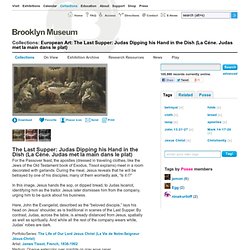
Judas met la main dans le plat) For the Passover feast, the apostles (dressed in traveling clothes, like the Jews of the Old Testament book of Exodus, Tissot explains) meet in a room decorated with garlands. During the meal, Jesus reveals that he will be betrayed by one of his disciples; many of them worriedly ask, “Is it I?”
The Sojourn in Egypt (Le séjour en Égypte) This work may be in the public domain in the United States.
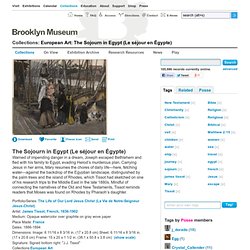
Works created by United States and non-United States nationals published prior to 1923 are in the public domain, subject to the terms of any applicable treaty or agreement. You may download and use Brooklyn Museum images of this work. Please include caption information from this page and credit the Brooklyn Museum. If you need a high resolution file, please contact reproductions@brooklynmuseum.org (charges apply). The Raising of the Cross (L'élévation de la Croix) This work may be in the public domain in the United States.

Works created by United States and non-United States nationals published prior to 1923 are in the public domain, subject to the terms of any applicable treaty or agreement. You may download and use Brooklyn Museum images of this work. Please include caption information from this page and credit the Brooklyn Museum. If you need a high resolution file, please contact reproductions@brooklynmuseum.org (charges apply). The Ascension (L'Ascension) This work may be in the public domain in the United States.
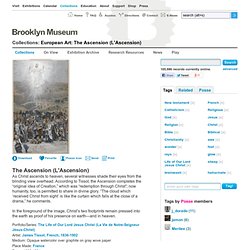
Works created by United States and non-United States nationals published prior to 1923 are in the public domain, subject to the terms of any applicable treaty or agreement. You may download and use Brooklyn Museum images of this work. Please include caption information from this page and credit the Brooklyn Museum. If you need a high resolution file, please contact reproductions@brooklynmuseum.org (charges apply).
The First Denial of Saint Peter (Premier reniement de Saint Pierre ) When warned by Jesus that he would deny him three times before the cock crowed—before the dawn—Peter vehemently objected, asserting his fidelity and pledging to die alongside Jesus.
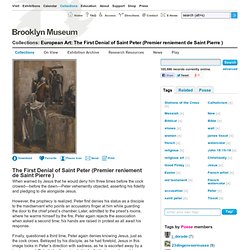
The Second Denial of Saint Peter (Deuxième reniement de Saint Pierre) When warned by Jesus that he would deny him three times before the cock crowed—before the dawn—Peter vehemently objected, asserting his fidelity and pledging to die alongside Jesus.

However, the prophecy is realized. Peter first denies his status as a disciple to the maidservant who points an accusatory finger at him while guarding the door to the chief priest’s chamber. Later, admitted to the priest’s rooms, where he warms himself by the fire, Peter again rejects the association when asked a second time; his hands are raised in protest as all await his response. Finally, questioned a third time, Peter again denies knowing Jesus, just as the cock crows. Betrayed by his disciple, as he had foretold, Jesus in this image looks in Peter’s direction with sadness, as he is escorted away by a jeering crowd. The Magnificat (Le magnificat) Saint Mark (Saint Marc) For his narrative of the life of Christ, Tissot created a “harmony” of the Gospels, combining the separate accounts of Jesus’ life attributed to the apostles Matthew, Mark, Luke, and John.
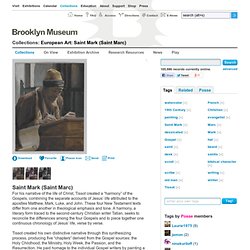
These four New Testament texts differ from one another in theological emphasis and tone. A harmony, a literary form traced to the second-century Christian writer Tatian, seeks to reconcile the differences among the four Gospels and to piece together one continuous chronology of Jesus’ life, verse by verse. Tissot created his own distinctive narrative through this synthesizing process, producing five “chapters” derived from the Gospel sources: the Holy Childhood, the Ministry, Holy Week, the Passion, and the Resurrection. He paid homage to the individual Gospel writers by painting a portrait of each. Herod (Hérode) The Miracle of the Loaves and Fishes (La multiplicité des pains) Jesus Walks on the Sea (Jésus marche sur la mer)